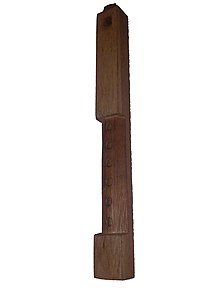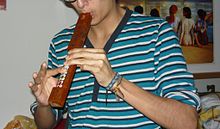Tarka (musical instrument)
The Tarka ( Quechua , Aymara : tharqa "rough, hoarse voice") is a beaked flute played in Andean music . Today the tarka is usually made of wood. The tarka is usually played in ensembles ( tropas , Spanish "troops") of up to 40 tarkas. Relatives of the tarka are quena , pan flute and recorder .
construction
The Tarka is constructed in a similar way to the recorder, both consist of a mouthpiece and a sound tube (middle piece and foot piece), but with the Tarka these cannot be dismantled. The parts form a tube with a cylindrical bore from the head to the foot. Compared to the modern recorder, the Tarka is rectangular in shape and usually has six equidistant finger holes. As with the recorder, the mouthpiece of the Tarka also has a labium, a blowing edge and a beak, the latter of which in the Tarka has an arch shape and is not attached to it but to the square mouthpiece or pipe.
Families and mood
There is a wide variety of tarkas, divided into families, that include two or more measures of length. The length measurements are in cm. calculated so that the instrument maker can determine the length of the main instrument in the tropa. The families differ in material ( rosewood , mahogany etc.), construction technique, drilling, origin and timbre .
The five big families are:
- Ullara
- Kurahuara
- Salinas
- Potosina
- Wallpara
The length or size of the tarkas is different in every family, but the proportion between the different lengths remains the same. Today we know three lengths:
- Taika 1 X
- Mala 2/3 X
- Ch'ili 1/2 X
The Taika is twice as long as the Ch'ili and sounds an octave lower, the length of the Mala corresponds to two thirds of the Taika , so it sounds a perfect fifth higher. The most common tunings are A, C, Eb and D flat.
The length measurements are only approximate, this also results in a slightly different mood. So there are no two identical flutes. Since every tarka has a slight deviation in the cent range, every tarka also produces a characteristic single tone that contributes to the expansion of the tonality of a tropa. For this reason, this does not always coincide with the uniform tempered mood standardized in the West .
tonality
With the Tarka you can play a diatonic scale with some restrictions , but in practice only a pentatonic scale is used, which is why some fingering combinations do not occur at all.
The major tonality of the pentatonic scale of a Tarka is derived from playing with the finger holes open, the minor tonality from playing with the first two finger holes. In the case of a Tarka tuned in C major / A minor, for example, the notes CDEGA are played.
Origin and function
The Tarka is mainly found in the Andean region in Peru and Bolivia , the exact origin is disputed. The oldest known evidence of bone tarcas is approximately 7,000 years old.
The Tarka was and is used at large festivals, rituals and ceremonies of great tropas, and a mystical function is ascribed to the Tarka, namely that of communication between the world of humans (Kay Pacha) and the world of the gods (Hannaq Pacha).
literature
- Thomas Turino: Moving away from silence. Music of the Peruvian Altiplano and the experience of urban migration (Chicago Studies in Ethnomusicology). The University of Chicago Press, Chicago, Ill. 1993, ISBN 0-226-81699-0 .
- Walter Sanchez: La música en Bolivia. De la prehistoria a la actualidad. Memoria del simposio internacional, October 2001 . Fundación Simon I. Patiño, Cochabamba, Bolivia 2002.

